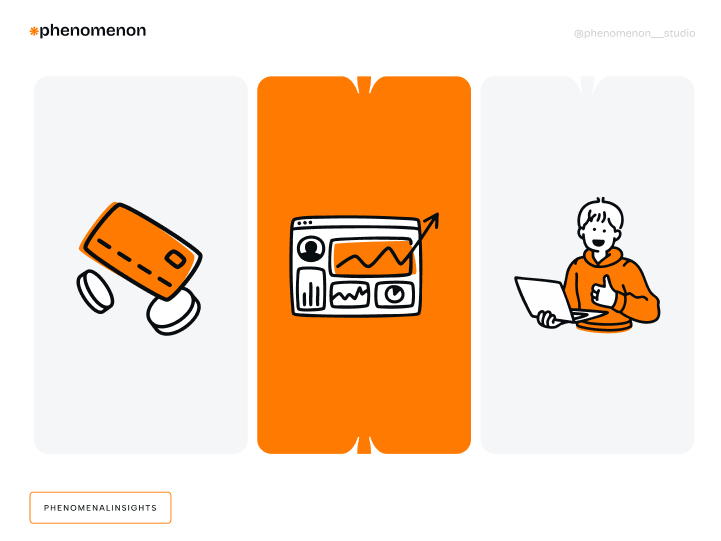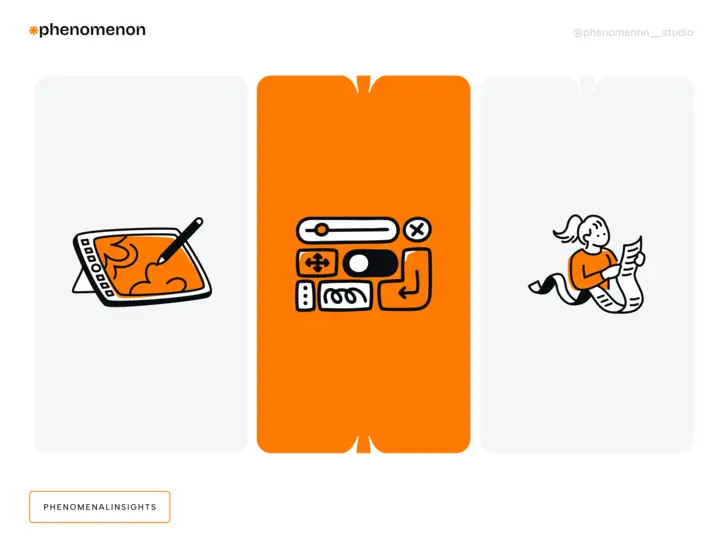The discovery phase plays a crucial role in product design. It enhances the likelihood of your product’s success, mitigating risks, improving the budget and timeline projections, and optimizing design and development expenses.
Before diving into the unknown, it’s critical to discover why, how, and what. Seems a bit obscure, right? To clarify things, we’re talking about the discovery stage, one of the paramount stages of product development. Poor or insufficient planning before the project launch can lead to an additional 50% expenditure beyond the initial budget for investors and business owners. This may result in inadequate funding for critical functionality or sufficient testing. As a result, the customer gets a finished project that will, at some point, fail miserably; it’s just a matter of time.
The discovery phase prevents the collapse — it ensures both the development team and the customer have a clear understanding of the following points:
- feasibility of the project/idea;
- potential time frames;
- resources critical to transform the idea into a product.
Since every new journey should commence with thorough analysis, the project’s discovery phase must be consistently included. Keep reading to learn what to expect from a discovery phase, its core deliverables, and the critical experts involved.
Defining the Discovery Stage
The discovery phase, known as initial research, precedes the beginning of project design. It focuses on identifying your target audience, its challenges, and requirements. During the discovery phase, we conduct extensive research, primarily to have a final and prioritized feature product list.
The discovery phase represents a data-driven approach to shaping your product. It concerns whether we are talking about the discovery logo design, the discovery design development deployment, the discovery software design, etc.
For example, in the discovery phase, a customer and the development team collaborate to define the objectives and vision for the wellness mobile app. They identify user personas, prioritize features, and create wireframes to visualize the app’s interface and navigation. They validate assumptions and mitigate risks through technical feasibility assessments and user research. These measures ensure that the final product meets the customer’s expectations, resonates with users, and minimizes costly rework during development.

Discovery Stage Objectives
The primary objective of the discovery stage is to dispel uncertainties and validate your product assumptions. Gathering feedback and data gives you the necessary insights to refine your concept, ensuring the final product aligns with user expectations and needs. But let’s get into more details:
1. Defining project scope, including the project’s purpose, objectives, and desired outcomes, to establish clear boundaries and deliverables.
2. Understanding stakeholder needs involves gathering insights into their vision, requirements, and preferences.
3. Identifying user needs by exploring their behaviors and pain points to ensure the solution will help them perform specific actions or provide unique functionality, differentiating the product from its closest competitors.
4. Feature prioritization is critical for balancing a limited product and an excess of unnecessary functionality that would drain the stakeholders’ resources.
5. Assessing the technical feasibility of implementing desired features within constraints, including time, budget, and available resources.
6. Identifying potential risks and challenges that may impact project success and develop strategies to mitigate them effectively.
7. Developing a roadmap by outlining the project timeline, milestones, and deliverables to guide project planning and execution.
8. Validating assumptions and hypotheses through user research, market analysis, and prototyping to ensure informed decision-making.
9. Providing a clear direction and strategy for the project, laying the groundwork for successful execution and delivery.
Although this list is not exhaustive, it includes core objectives for every project regardless of its scope, size, and industry
Benefits of the Design Discovery Process
We’ve identified several benefits that will persuade you to request a design discovery process from your chosen software development partner.
Understanding User Needs
During the discovery stage, we conduct in-depth research to understand the target audience, their problems, and their needs. This information is essential for developing a product that addresses real-world user concerns. Without this understanding, a product may fail to meet user expectations.
For example, let’s consider a wellness app mentioned earlier. In developing a wellness app, it’s essential to understand the diverse needs and preferences of users like Emily, a 32-year-old marketing manager balancing a busy lifestyle. Emily’s challenges include time constraints, lack of motivation, and information overload when maintaining her well-being amidst her demanding schedule. She seeks convenient solutions for improving fitness, balanced nutrition, and stress reduction while desiring accountability and support to stay on track with her wellness goals. By empathizing with users like Emily and addressing their pain points and goals, the wellness app can offer tailored solutions and support, ultimately empowering users to lead healthier and more fulfilling lives.
Risk Mitigation
Discovery for design ensures early identification and mitigation of risks. Using a set of features focused on the problems of the central TA segment, potential issues, and challenges can be uncovered before significant resources are invested in development. This proactive risk management can save time and money in the long run.
Cost Efficiency
Addressing issues and refining your product concept in the discovery stage is far more cost-effective than making changes during later stages of development. Identifying and solving problems early can prevent costly revisions and delays.
User-Centric Design
The discovery of user interface design helps us follow our main principle of a user-centric approach to product design. It ensures the product is designed with the end-user in mind, leading to a more user-friendly and satisfying experience. User satisfaction is a key driver of product success.
Data-Driven Decision-Making
The phase relies on data and feedback to make informed decisions. This data-driven approach minimizes subjective assumptions and biases, making it more likely that the product will cater to actual market conditions and user preferences.
Competitive Advantage
Products that undergo a rigorous discovery phase are often better positioned in the market. They are more likely to stand out from the competition, as they are designed with a deeper understanding of what users truly need and value.
What is Included in the Discovery Phase?
Let’s consider the main stages of the discovery stage, which we follow in our full-service studio.
UX audit
This is an optional step for those who already have the product. We analyze the product from the point of view of usability and the general rules of UX design. This is the best way to understand how your potential customers interact with your product, how they can be converted, and how to make their experience as comfortable as possible. As a result, you get a list of product issues that you can use to make spot improvements without a global redesign.
Competitive analysis
This is identifying competitors in your industry and researching their different design decisions. We can use this information as a point of comparison to determine your company’s strengths and weaknesses relative to each competitor. Understanding how competitors do the same job as the client’s product allows you to figure out how to do it even better.
Best practices analysis
At this stage, we are searching for best practices to implement in this product. This is an opportunity to bring something new from other niches, thereby getting a more exciting user experience, which can even become a competitive advantage.
Feedback analysis
This is an analysis of user feedback about competitors’ products. This stage allows us to identify competitors’ weaknesses, strengthen our own, and sometimes adjust the business model.
Detailed user flow for each feature
User flows are diagrams representing a typical user’s path when using your product to complete a task. They visually depict the fundamental functions and illustrate how users engage with them. Consider them akin to a blueprint used when constructing a house. The primary value of this stage is that in a relatively small number of hours (relative to the overall project), you can see the whole picture and correct the identified shortcomings.
Personas
One method we use to analyze the product more accurately and understand its target audience’s primary needs and problems is persona formation. You can use user interviews, categorize them, and synthesize the main personas from actual user data to form personas. This helps us remember for whom the product is made and makes it easier to make design decisions.
Jobs-to-be-done (JTBD)
“Jobs-to-be-Done theory” is based on the fact that a person “hires” (buys) a specific product or service to solve existing problems to achieve progress (improvement) in his life. So, we focus on the moment of product consumption; we try to understand when and under what conditions the customer first thought about buying a product (that is, what happened BEFORE starting to use it).
Feature prioritization and description
The list of features is a general list of all product functionality. It is the final stage of all research stages and forms the basis of the future product. Not all project features are as important as they seem at first glance. Prioritization helps you stay focused and save the team time. This is where the final scope of the project is formed. At this stage, we will already have a project budget.
Backlog document with product features prioritized & described
A product backlog is a prioritized list of features the design team has gathered at various stages of the discovery phase, which will later become the basis for designing & developing a new product. Thanks to this, we can plan the project step by step.
Estimate – product
At this stage, we can already estimate the potential volume of work on the product. We also get a complete understanding of the required budget in several scenarios (optimistic and pessimistic).

Who is Involved?
The success of a product hinges significantly on the expertise of the team involved. Equally crucial to the team’s effectiveness is its structure, which complements the selection of highly qualified specialists. The standard set of roles for the discovery phase in design thinking includes:
Business Analyst:
-
- Requirements Gathering: BAs are skilled in collecting, analyzing, and documenting requirements. In the discovery phase, this is crucial for understanding business goals, user needs, and stakeholder expectations.
- Problem Identification: BAs help identify challenges and opportunities, which serve as the foundation for the project. They ensure that the project aligns with the company’s strategic objectives.
UX Designer:
-
- User-Centered Design: UX designers focus on creating a product with excellent user experience. In the discovery phase, they conduct user research and design user interfaces that meet their expectations.
- Scalability and Feasibility: Designers assess the feasibility of the proposed solution and ensure it’s scalable to meet future demands.
Project Manager:
-
- Planning and Coordination: Project Managers are pivotal in planning and coordinating activities during the discovery stage. They ensure that the project stays on track and that goals are met.
- Risk Management: Project Managers identify and mitigate risks that could impact the project’s success.
In summary, these roles are essential in the discovery stage for the highest quality research. It is hard to imagine this process without any of them. Their collective expertise and contributions during this phase significantly increase the chances of a successful product design process.
Final Words about the Discovery Phase
The discovery stage lays the foundation for generating all project documentation, resulting in cost savings for the client and time efficiency for the design team. Furthermore, it aids the client in formulating a product concept tailored to the end-user.
Our company’s discovery design development adheres to the most rigorous industry standards. It creates a comprehensive framework for both the design team and the client, facilitating the creation of innovative and intricate solutions. This phase dissects your idea and furnishes you with the essential insights needed to make well-informed decisions.
The time to act is now! Contact us immediately to discover your design and expedite your journey from vision to success.
FAQs
What is the difference between the discovery stage and market research?
The discovery stage involves understanding project objectives, requirements, and constraints, while market research focuses on analyzing the market landscape, competitors, and industry trends.
How long should the discovery stage last?
The duration of the discovery stage varies depending on the project’s complexity but typically lasts from a few weeks to a couple of months.
Can the discovery stage be revisited during product development?
Yes, the discovery stage can be revisited during product development to address new insights, changes in requirements, or unforeseen challenges.
How do you measure the success of the discovery stage?
The success of the discovery stage can be measured by the clarity and alignment achieved among stakeholders, the identification of key project risks and challenges, and the quality of insights gathered to inform subsequent project phases.
Are there specific tools or methodologies recommended for the discovery stage?
Recommended tools and methodologies for the discovery stage include stakeholder interviews, user surveys, workshops, prototyping, user journey mapping, and design thinking or lean UX techniques.













